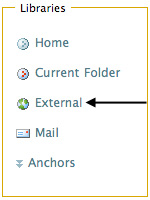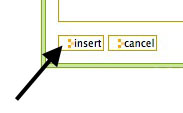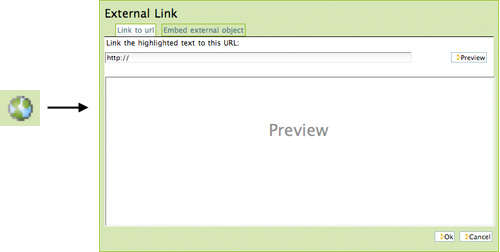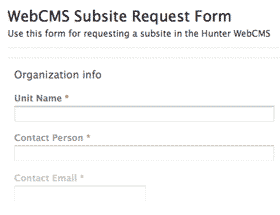How do I link to another page outside of the WebCMS?
A link from a page in the WebCMS to a page outside of the WebCMS is called an external link.
The below tutorial will guide you through adding an external link on a page in your WebCMS subsite. If you want to add an external link in your navigation menu, you may want to consider using a superlink instead.
How you create an external link on a page depends on the text editor you're using:
How to Create an External Link Using the TinyMCE Text Editor
- Start by navigating to the page you'd like to edit and accessing the Edit Page screen. (Need help with this step?)
- In the Body Text area, highlight the text you want to turn into a link.

- Click on the chain link icon in the formatting toolbar. A box titled Insert/Edit Link should appear.

- Click on External under Libraries in the left column.

- Underneath where it says Link URL, enter the complete web address you'd like to link to.
Note: Use the drop-down menu to select your prefix (such as http://). Be careful not to include this prefix in the URL twice.

- To make sure your link works, click on the Preview button. The target web page should appear in the Preview window.

- Click on Insert.

- You may now continue to edit your page. When you're done, remember to click Save.

How to Create an External Link Using the Kupu Text Editor
- Start by navigating to the page you'd like to edit and accessing the Edit Page screen. (Need help with this step?)
- In the Body Text area, highlight the text you want to turn into a link.

- Click on the globe icon in the formatting toolbar. A box titled External Link should appear.

- In the text box, type the complete web address you'd like to link to.
Note: You must include http:// at the beginning of the URL, but keep in mind that this is already in the field by default. Be careful not to include it in the URL twice.

- To make sure your link works, click on the Preview button. The target web page should appear in the Preview window.

- Click on Ok.

- You may now continue to edit your page. When you're done, remember to click Save.

I don't know which text editor I'm using.
Short Answer:
If your formatting toolbar is blue, you're using TinyMCE.
If your formatting toolbar is green, you're using Kupu.
Long Answer:
There are many differences between the Kupu and TinyMCE text editors. We strongly recommend using TinyMCE. If you would like to change your text editor from one to the other, click here to learn how.






